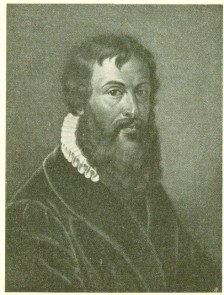Peter Schöffer facts for kids
Peter Schöffer (born around 1425, died around 1503) was an important early German printer. He first studied in Paris and worked as a copyist, someone who copied books by hand. Later, he joined Johannes Gutenberg, who invented the printing press, and then worked with Johann Fust, a goldsmith and businessman.
Some of his most famous works include the 1457 Mainz Psalter, the 1462 Bible (also called Biblia pulcra or "beautiful Bible"), and the 1484 Herbarius latinus.
Life and Printing Work
Schöffer was born in Gernsheim. He was a key helper for Johannes Gutenberg, who created modern typography (the art of arranging type). Gutenberg's famous 42-Line Bible was finished in 1455.
In 1457, Schöffer and Fust started their own printing company called Fust and Schöffer. This happened after Fust took over Gutenberg's workshop.
Some of their most famous books include the Mainz Psalter from 1457. They also printed the 1462 Bible, which was the fourth Bible ever printed. Another important book was Herbarius – Rogatu plurimorum... from 1484. This book is usually called the "Herbarius latinus".
The Herbarius was a very popular book about plants and medicines. It described 150 plants and 96 common medicines. It was reprinted ten times before the year 1499.
Schöffer is known for many new ideas in printing. He was one of the first to put dates on books. He also added title pages and used colored inks in his printing. After starting his own business, Schöffer mainly printed books about religion and law. He died in Mainz.
Around 1470, Schöffer bought a building in Mainz called the Humbrechthof. This building was later known as Schöfferhof.
Family and Legacy
Peter Schöffer married Christina, who was Johann Fust's only daughter. His sons also became printers. His son, John, continued the printing business from 1503 to 1531.
Another son, Peter the younger, was a skilled printer and worked in many cities. These included Mainz, Worms, Strasbourg, and Venice. In 1526, Peter the younger printed the first English New Testament in Worms. It was translated by William Tyndale. Peter the younger's son, Ivo, also continued the printing business in Mainz.
The name Schöfferhofer is now a brand of German wheat beer. It is named after Peter Schöffer's old house in Mainz, the Mainzer Schöfferhof. A brewery was founded in this house. The beer brand even uses a picture of Peter Schöffer as its symbol.
In her 2014 novel Gutenberg's Apprentice, Alix Christie wrote about the invention of printing. She explored the ideas of who invented what, especially between Schöffer and Gutenberg.
See also
 In Spanish: Peter Schöffer para niños
In Spanish: Peter Schöffer para niños
- Mammotrectus super Bibliam


